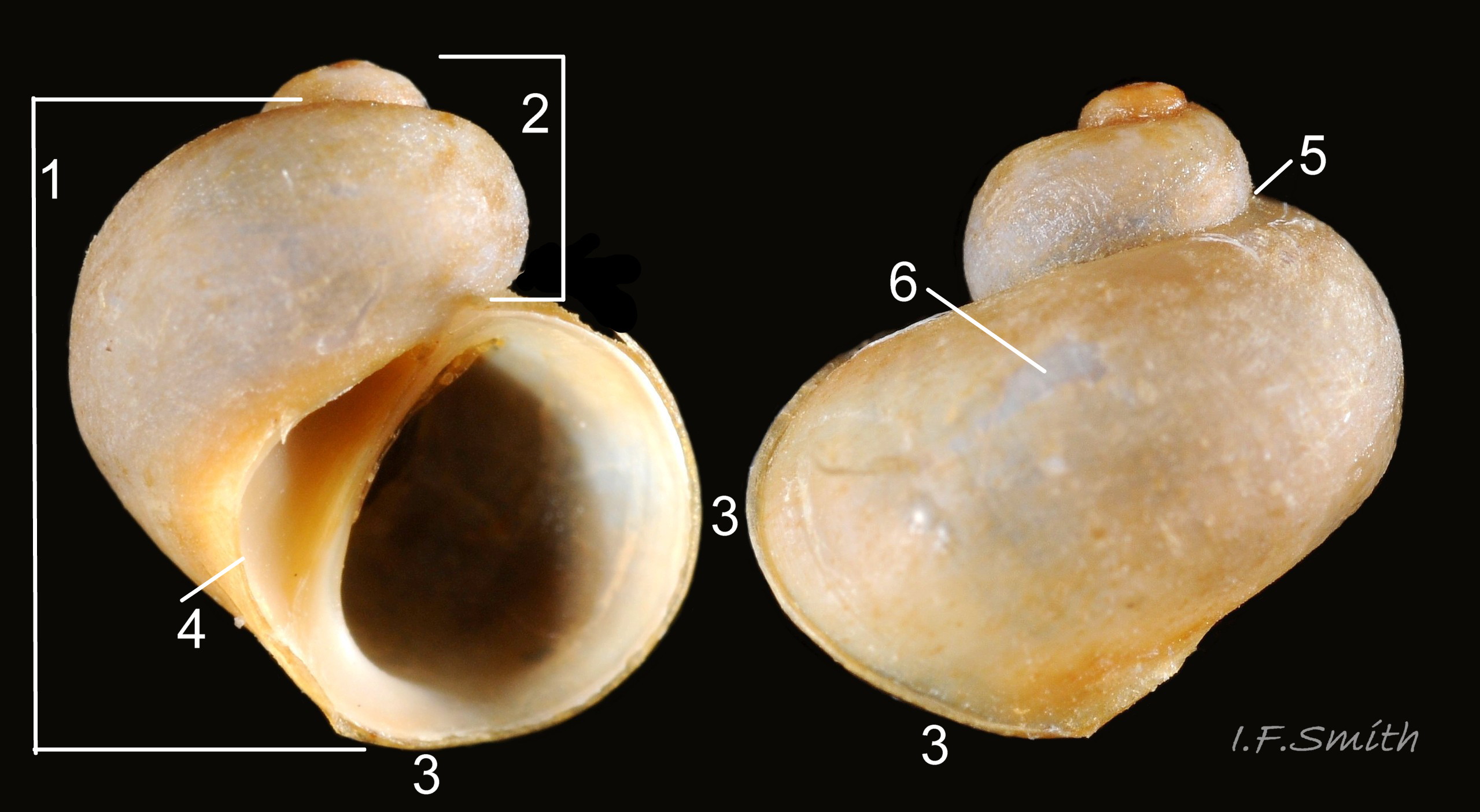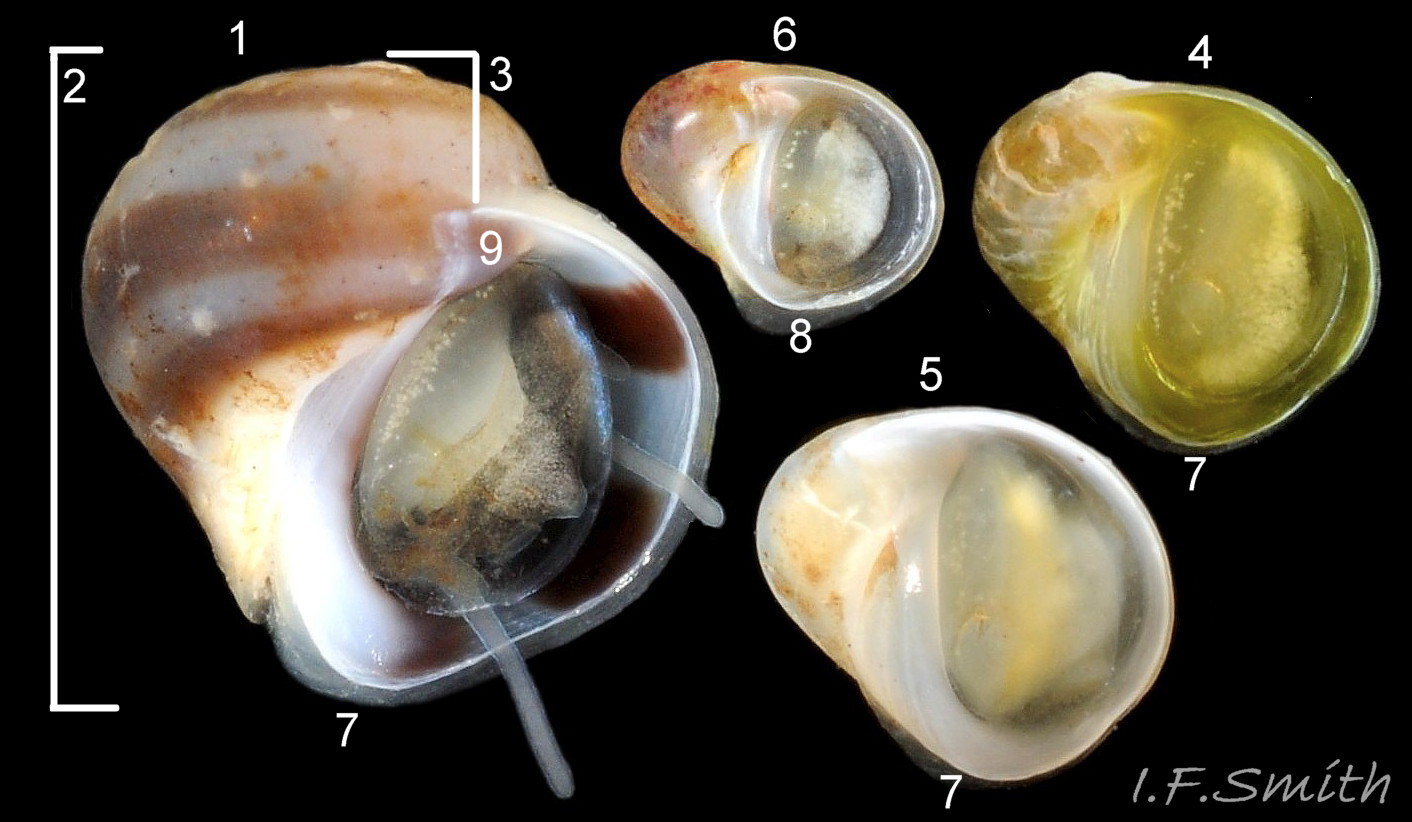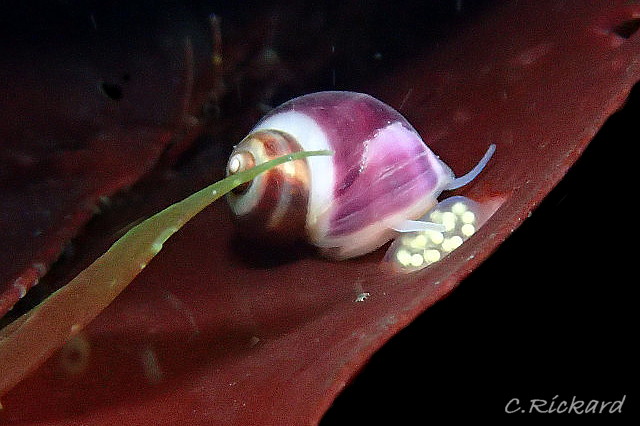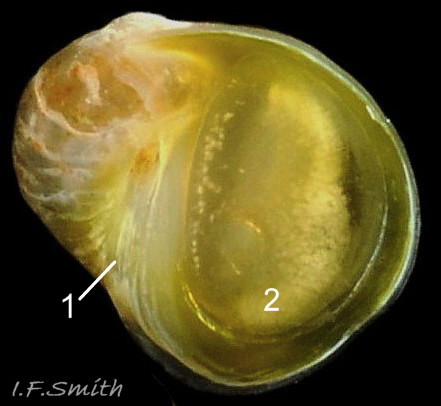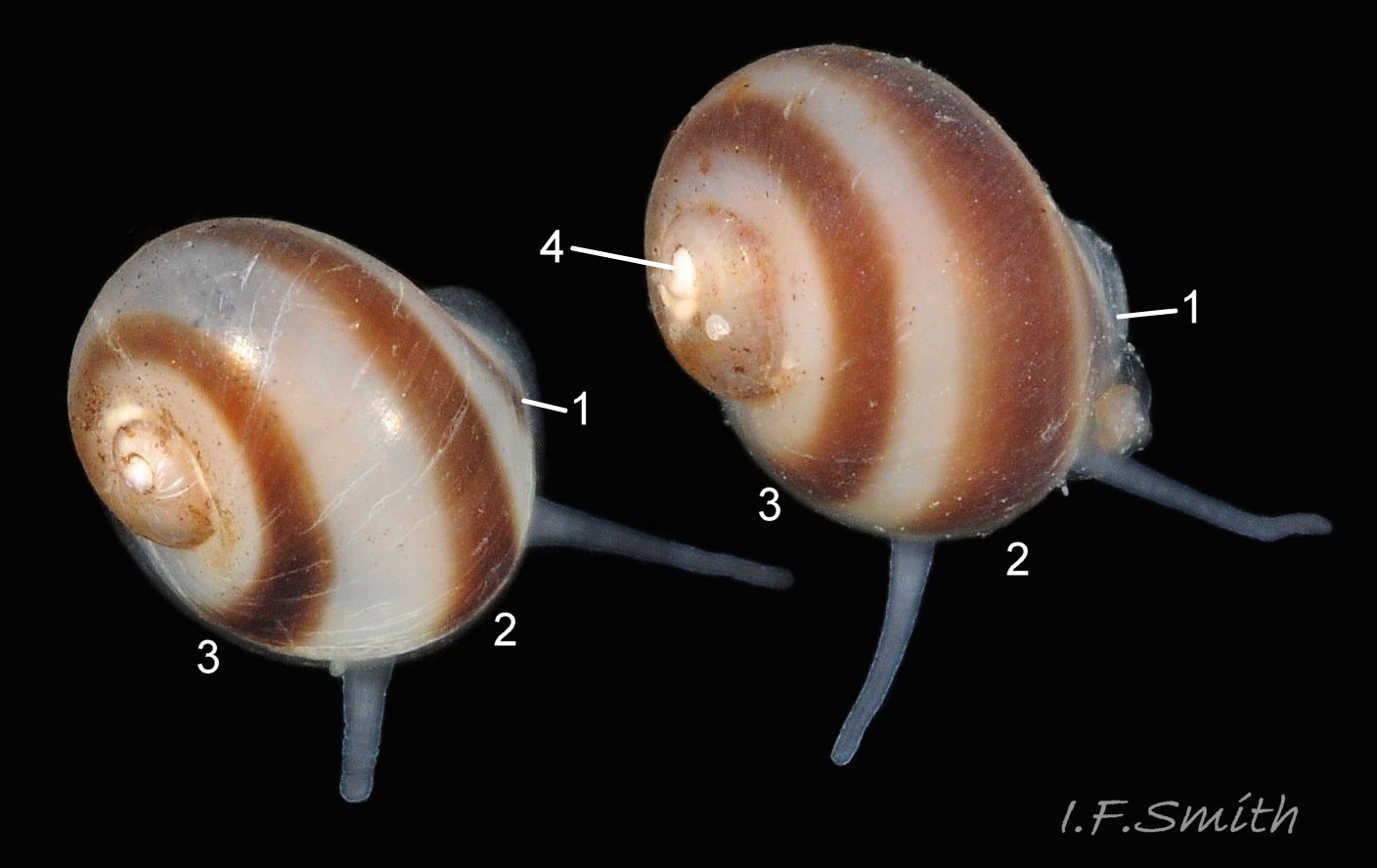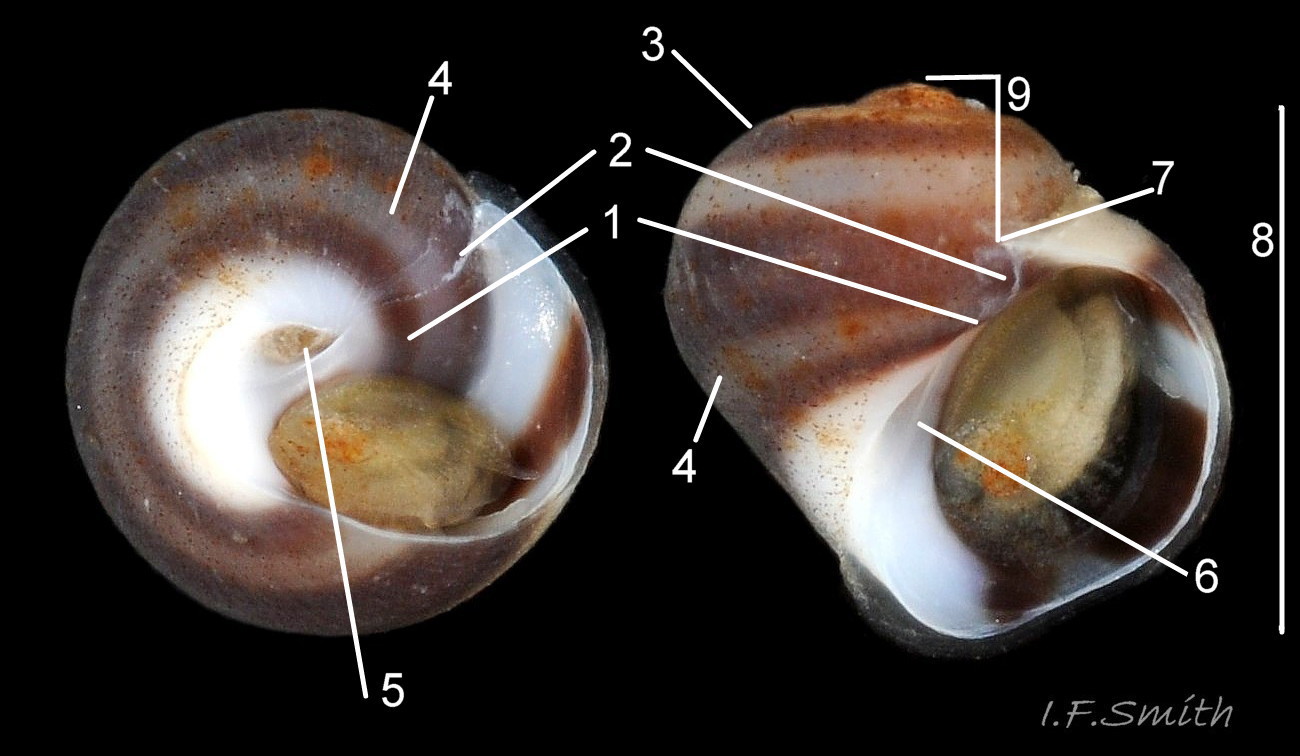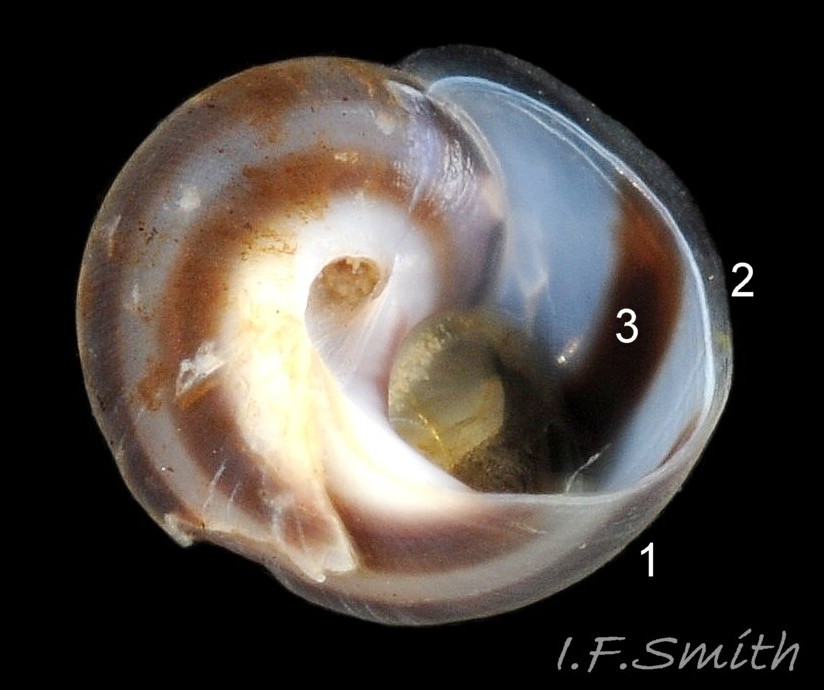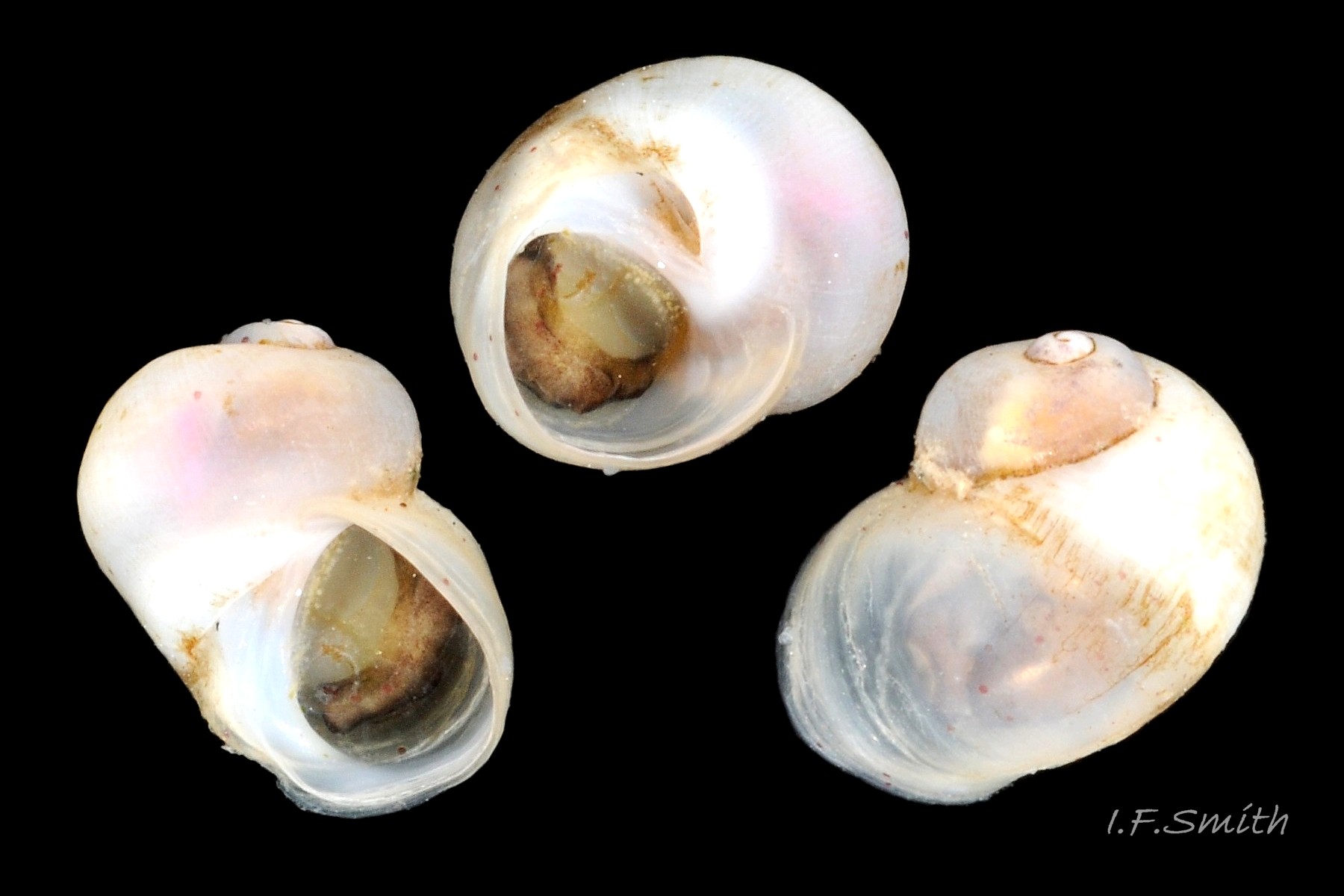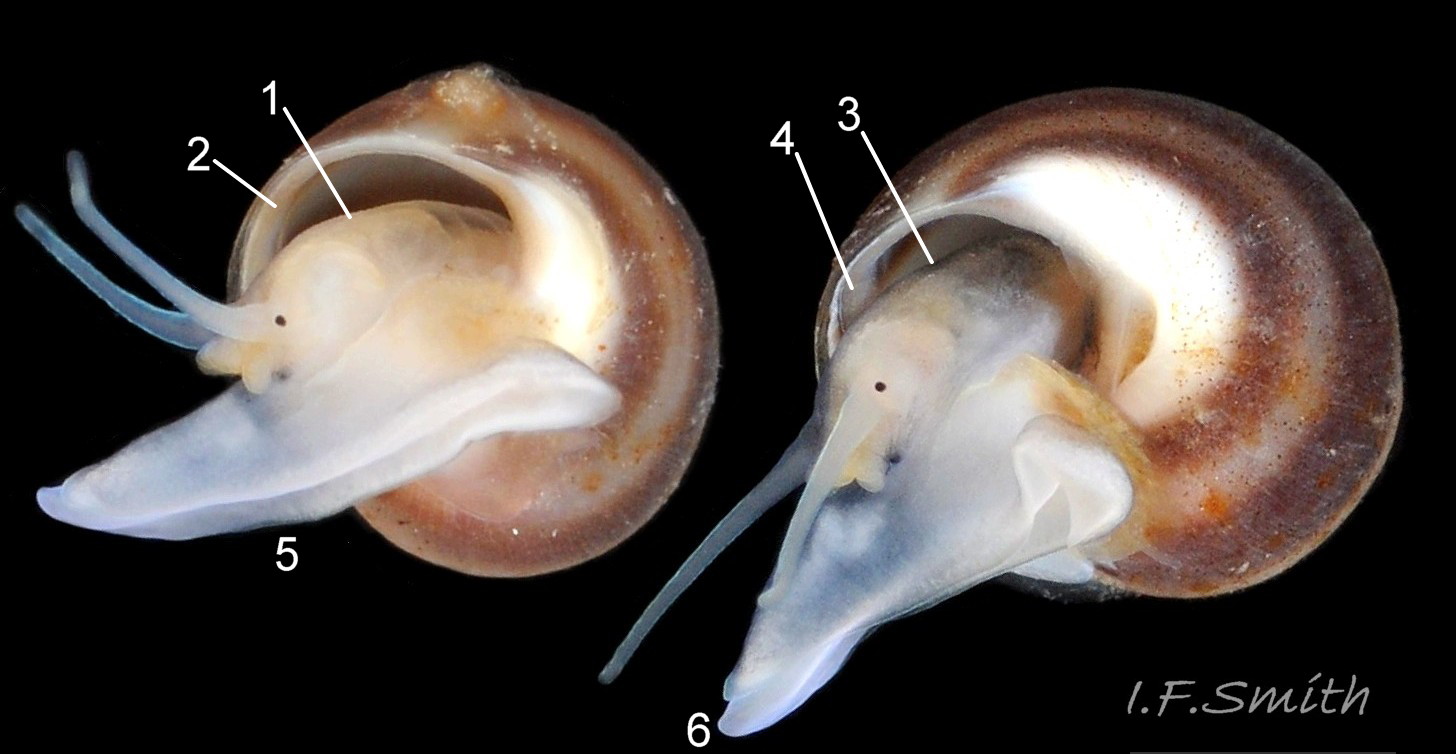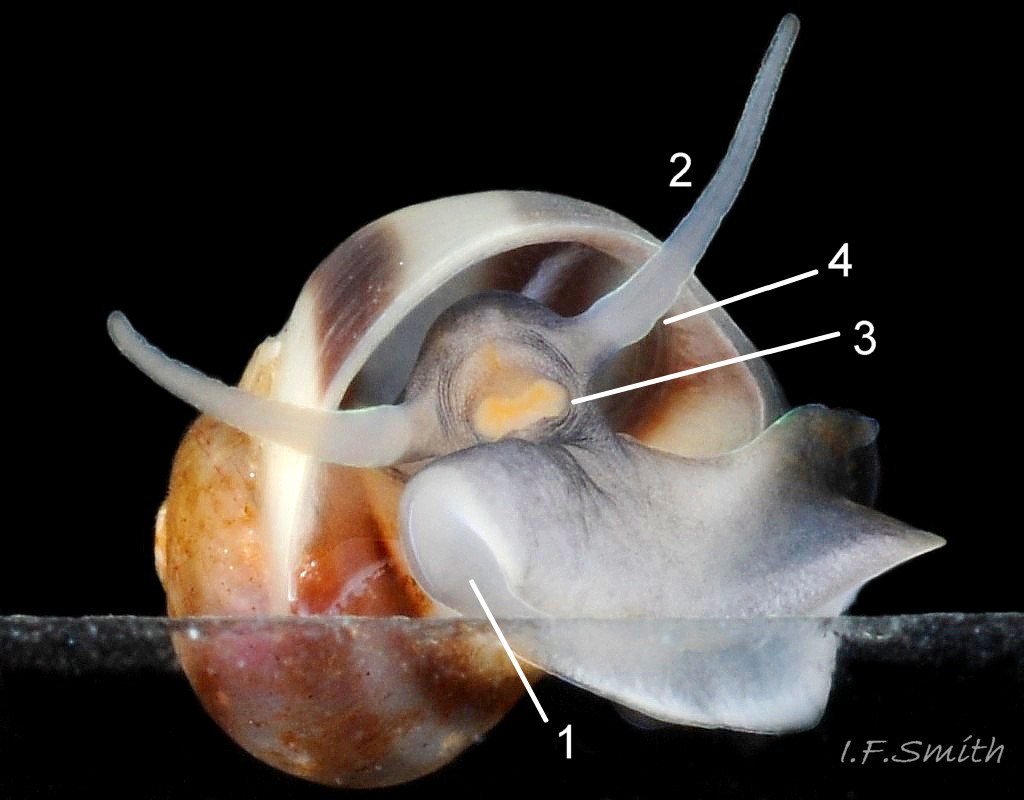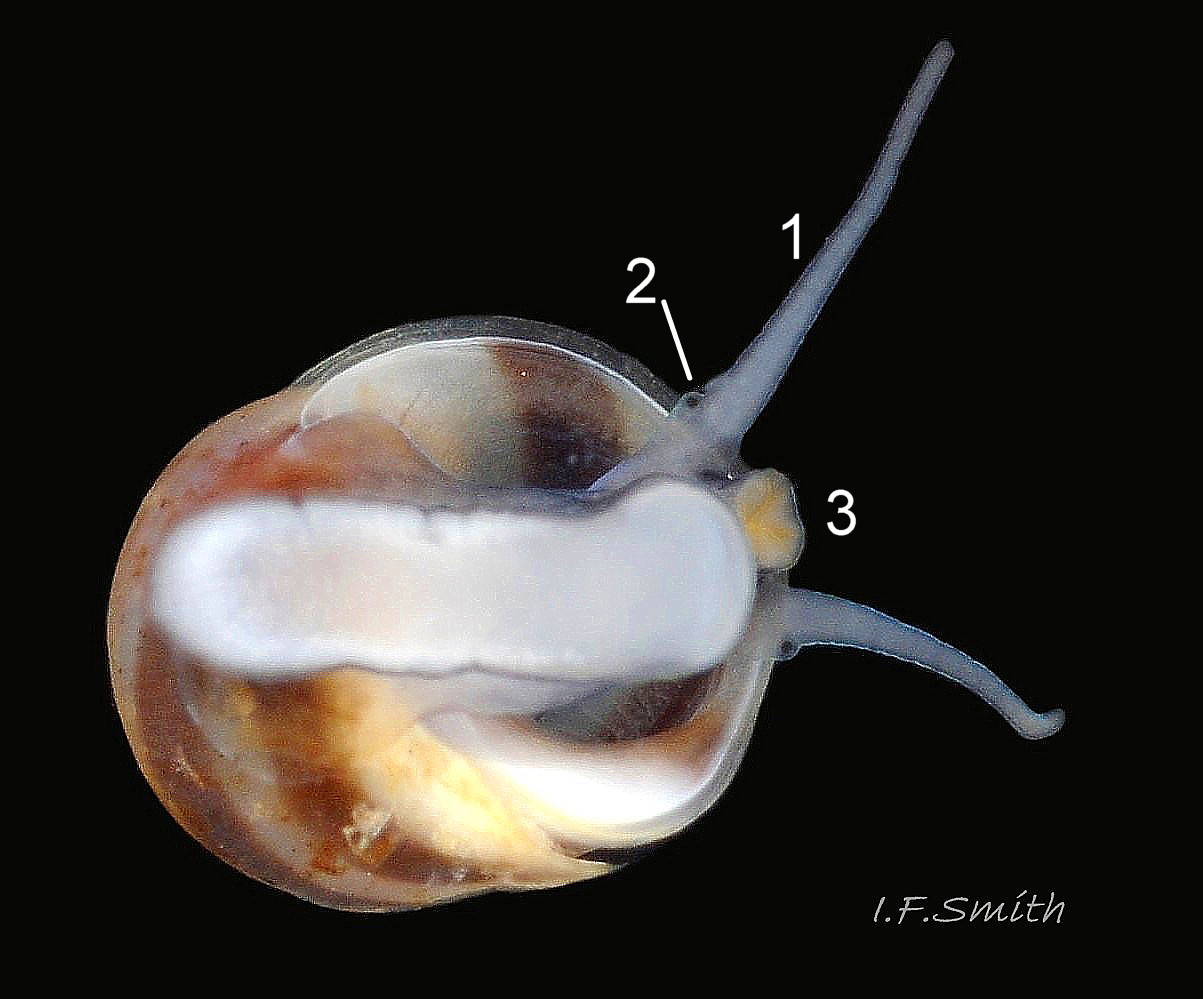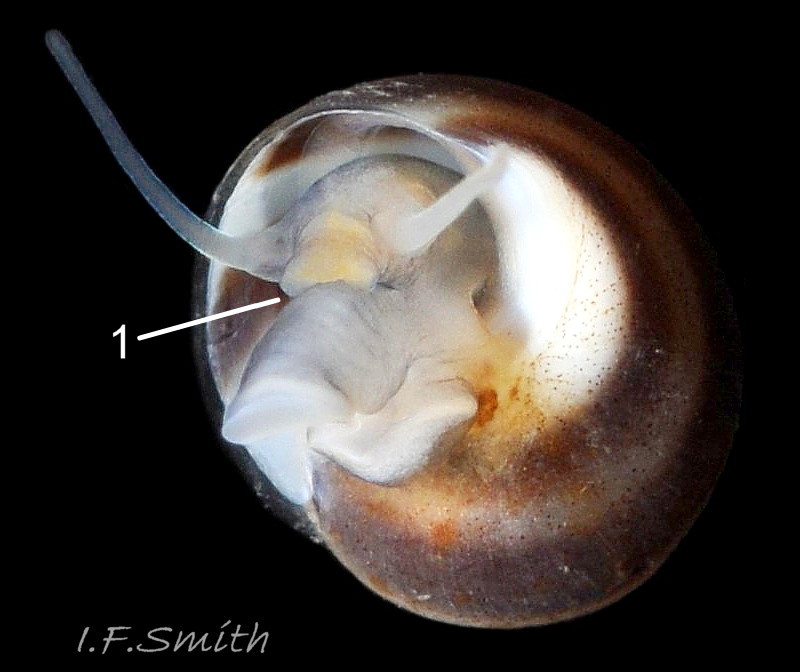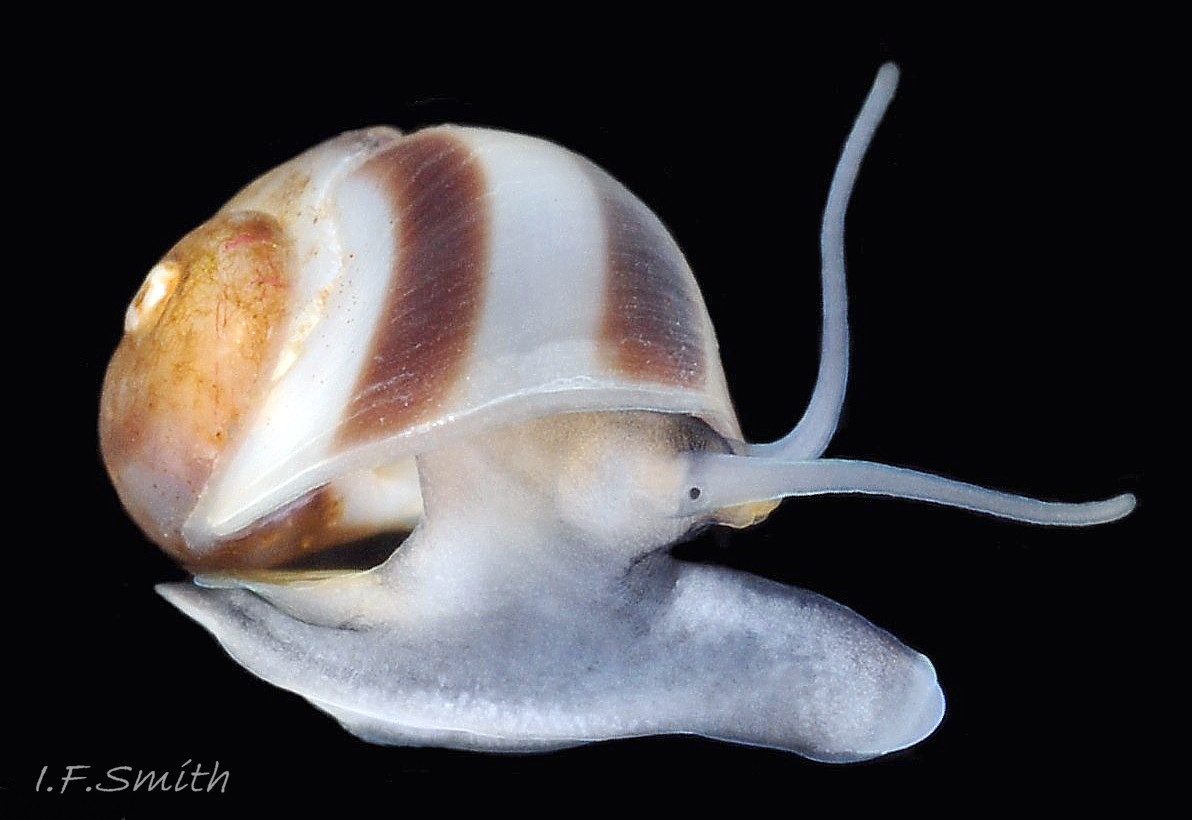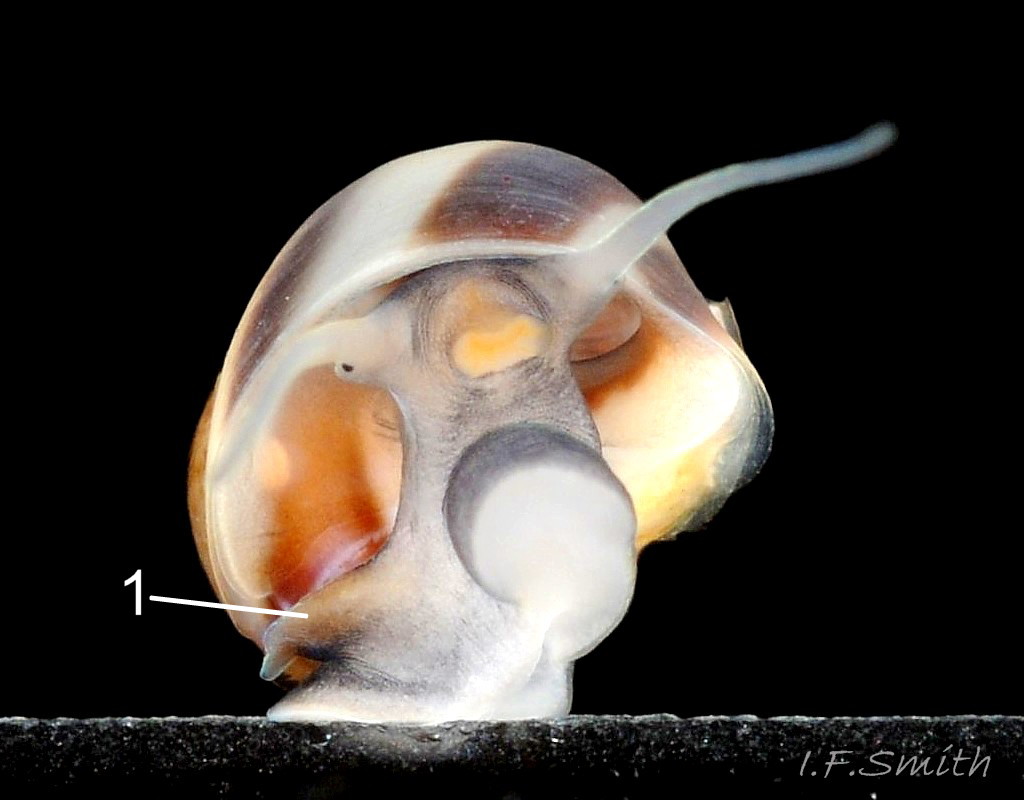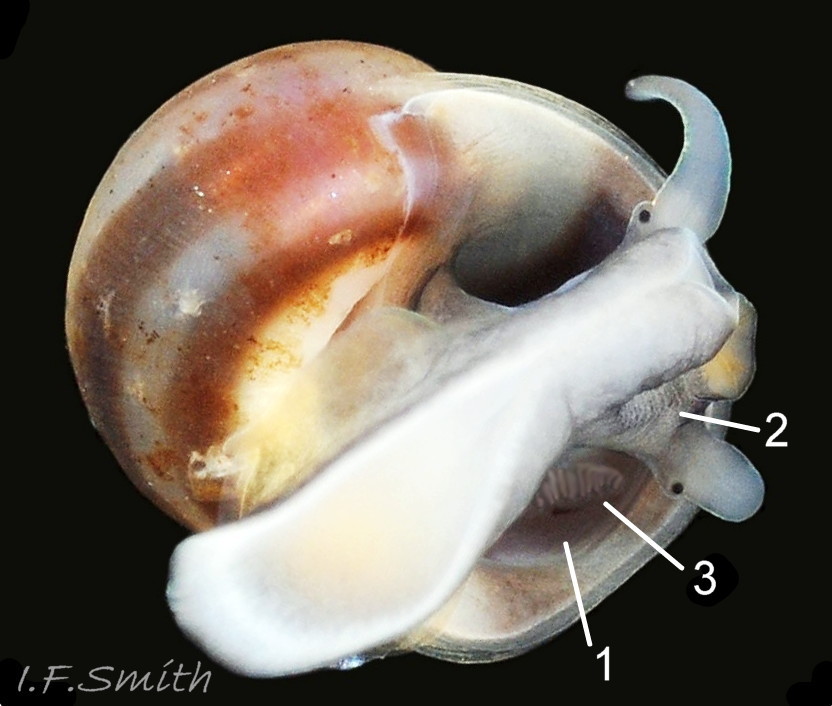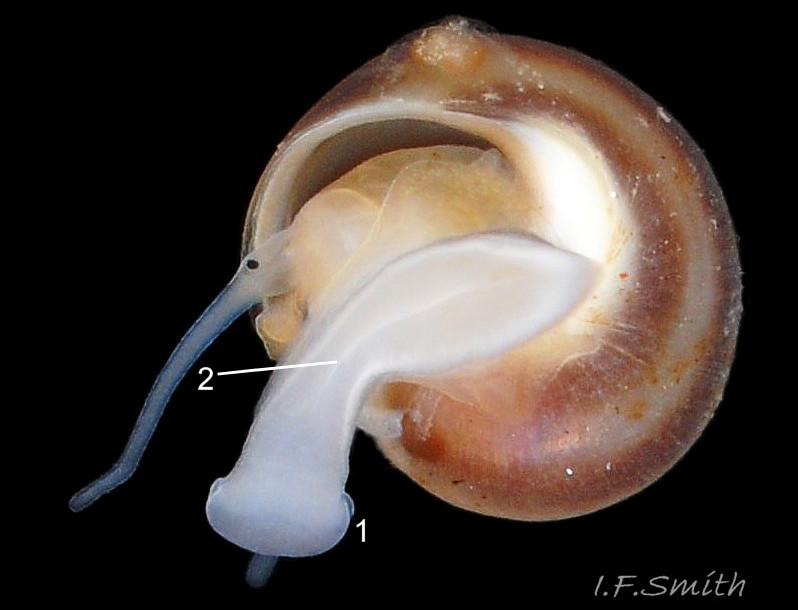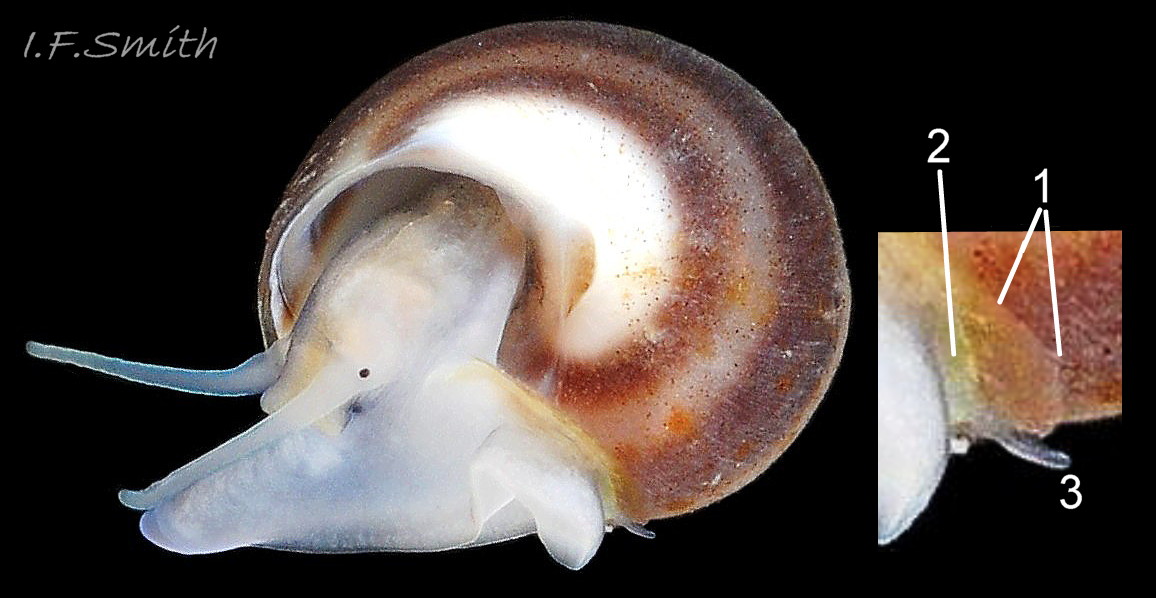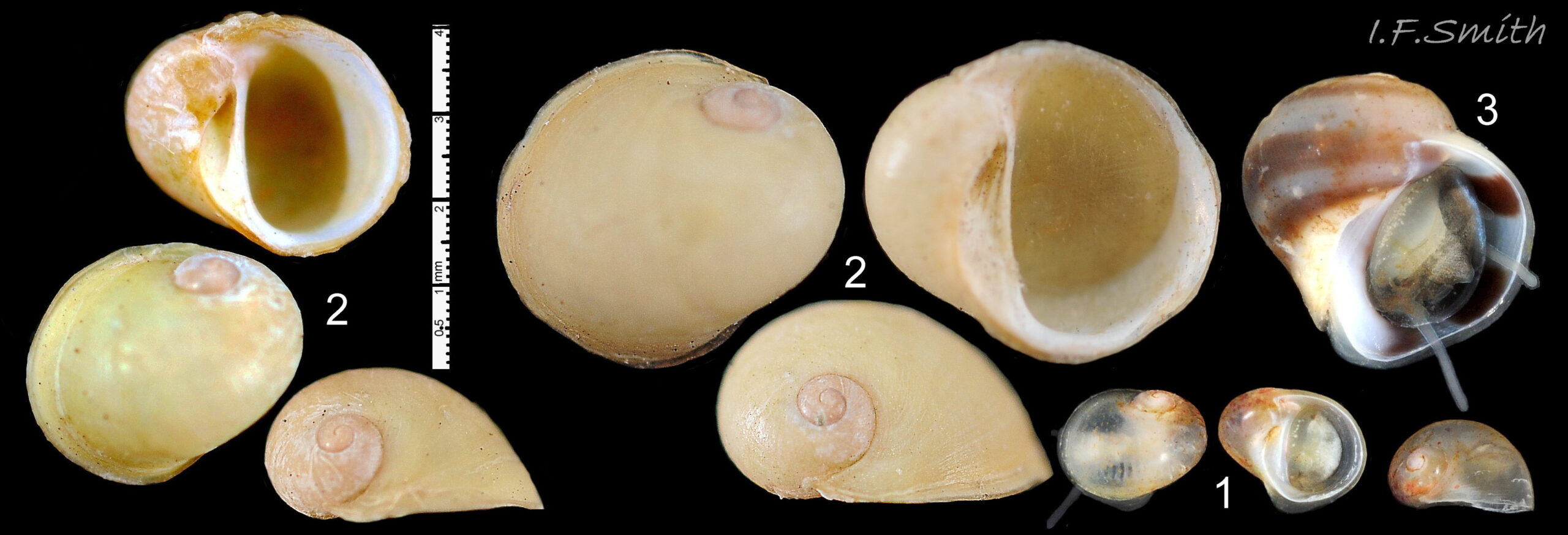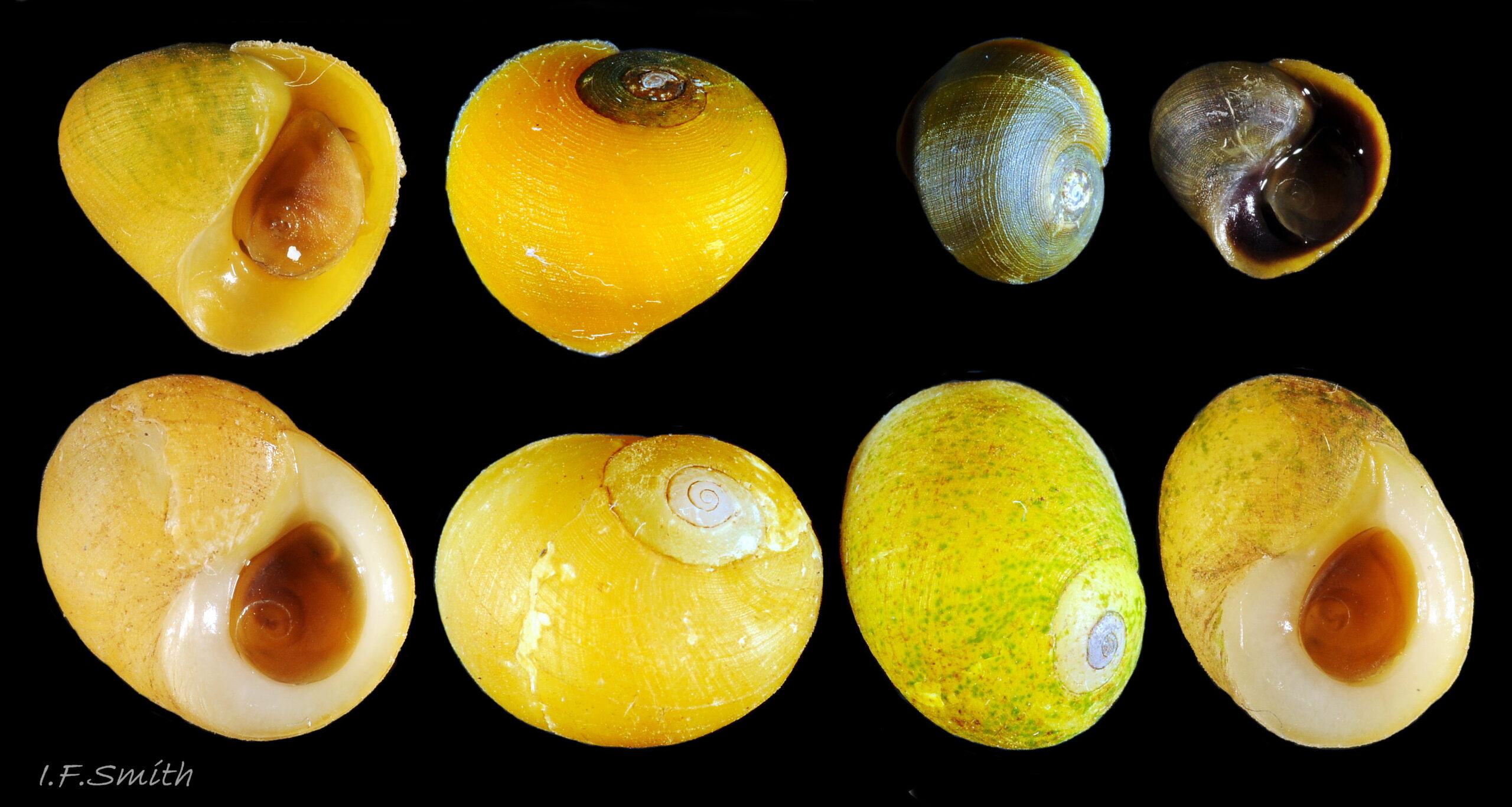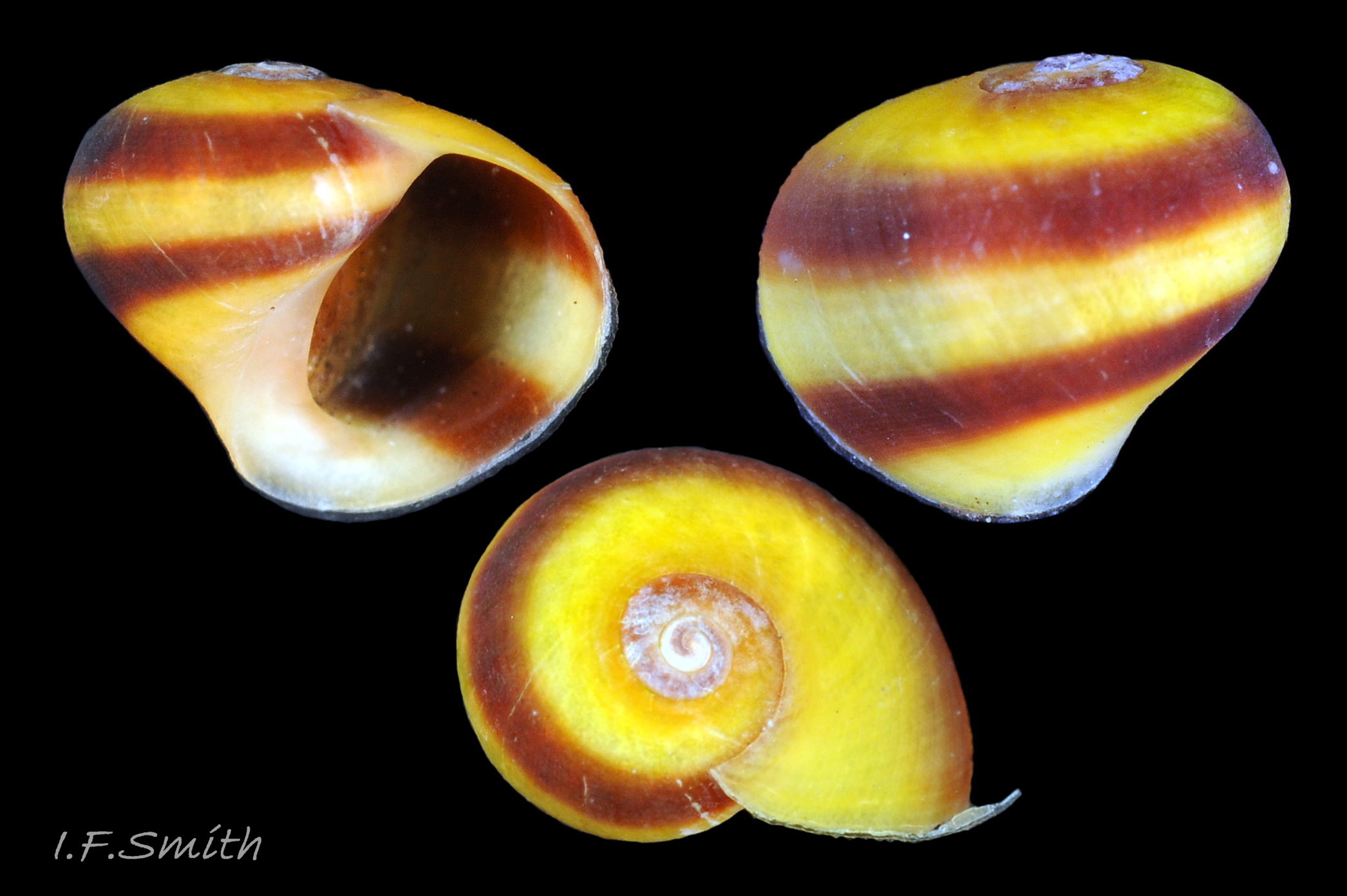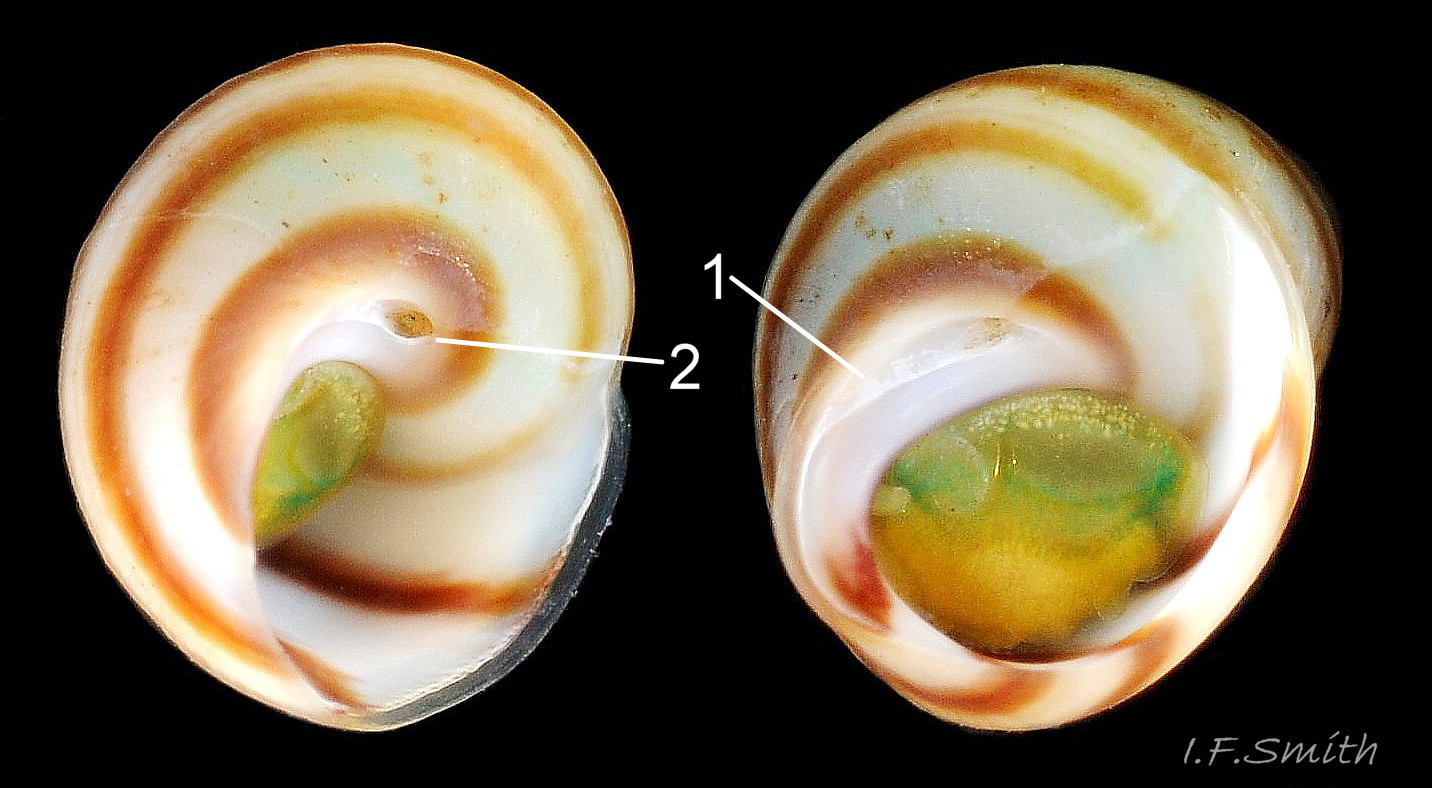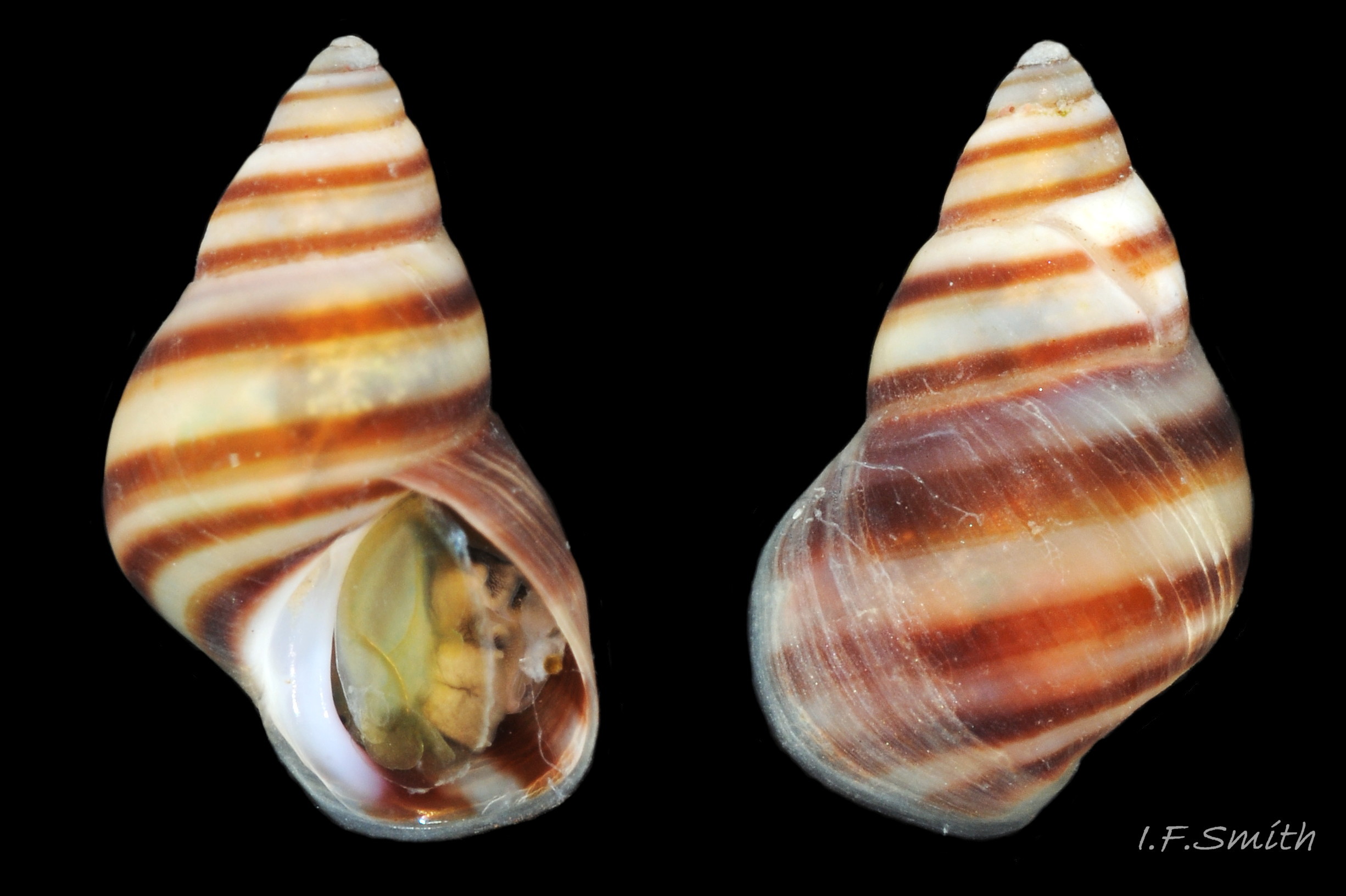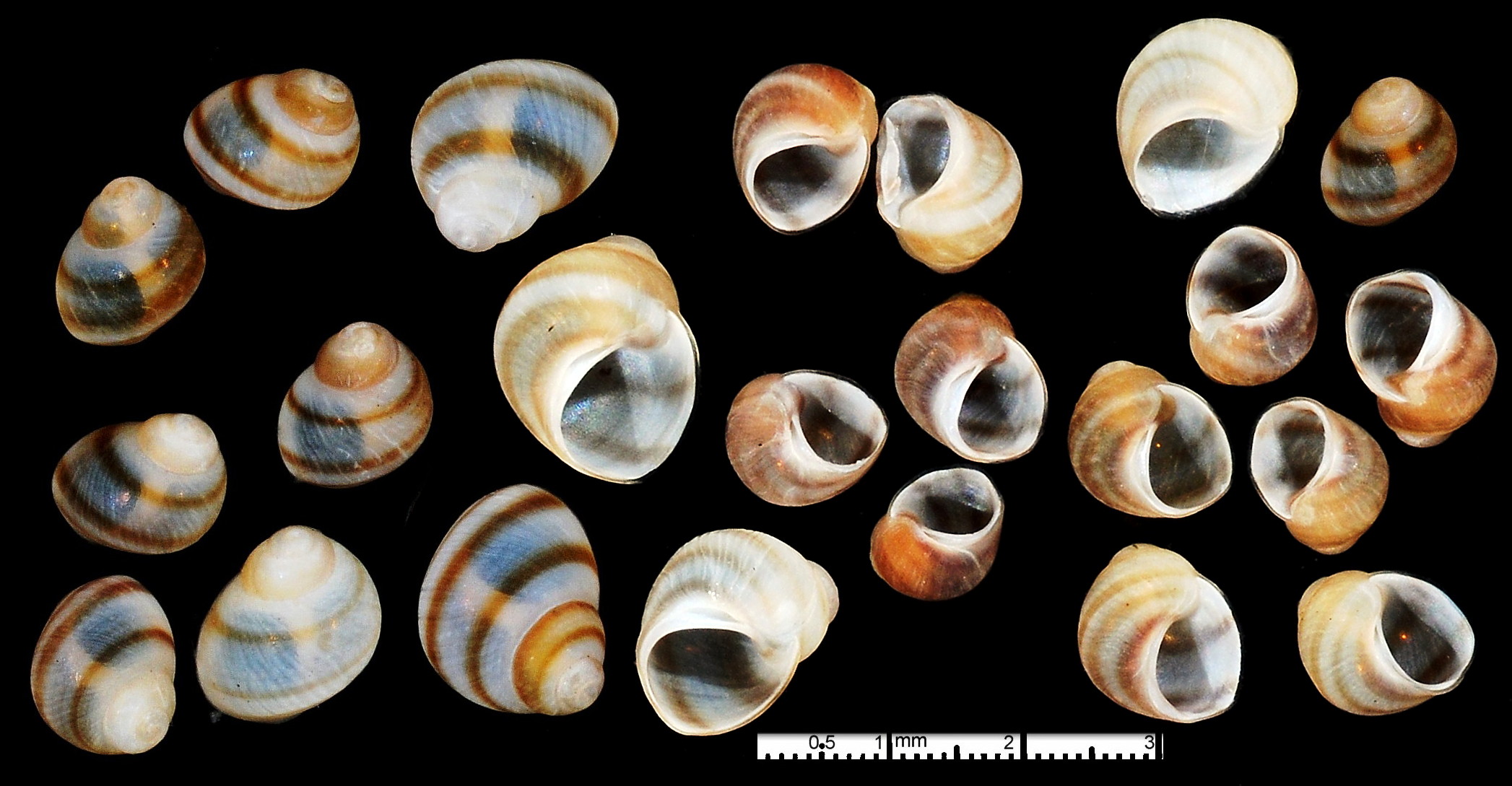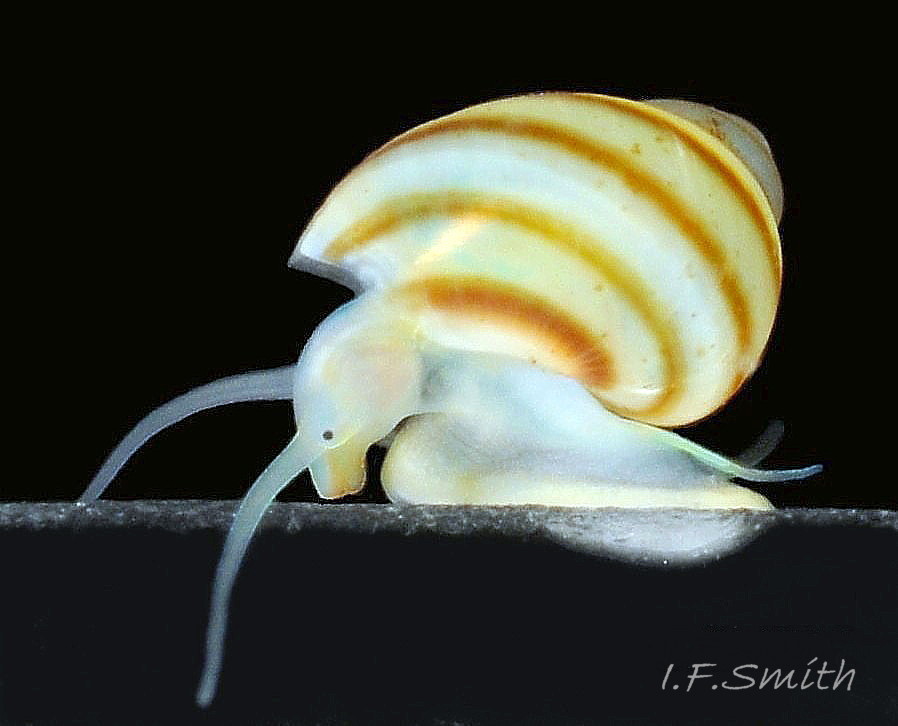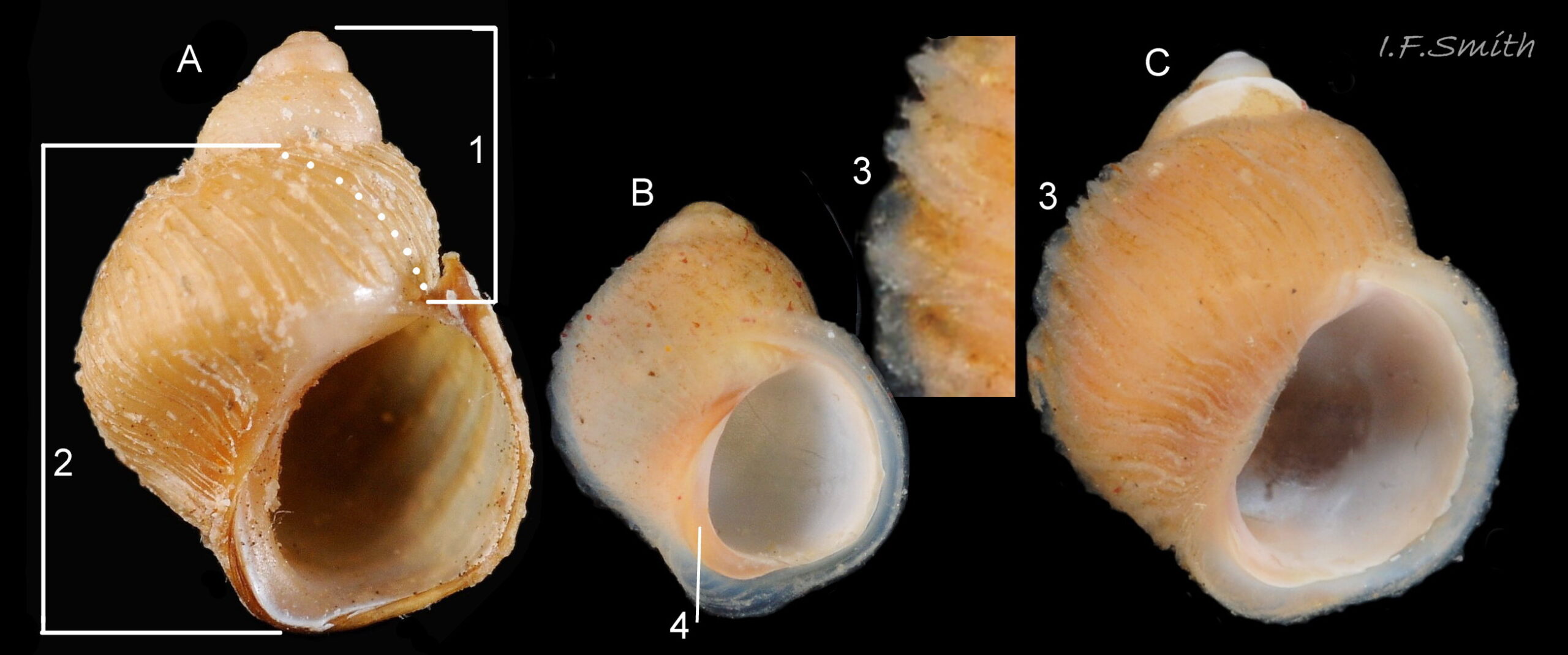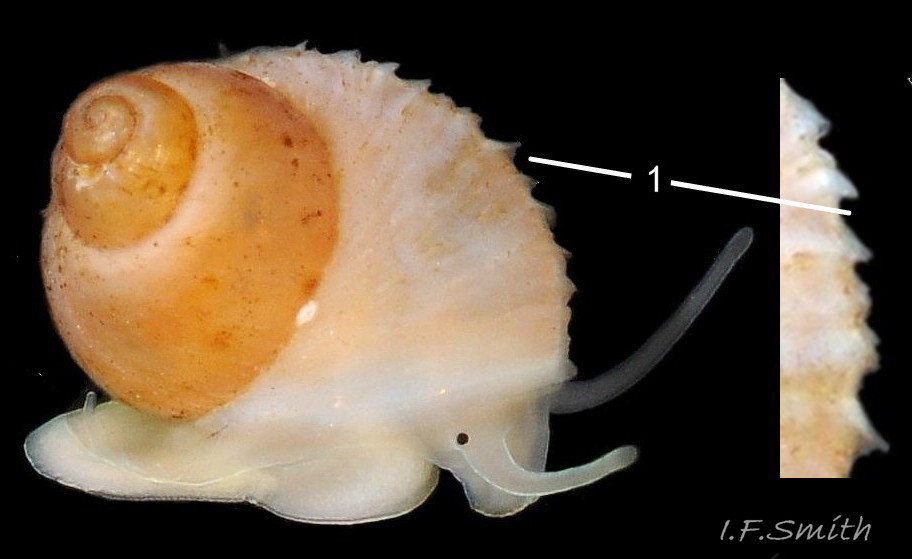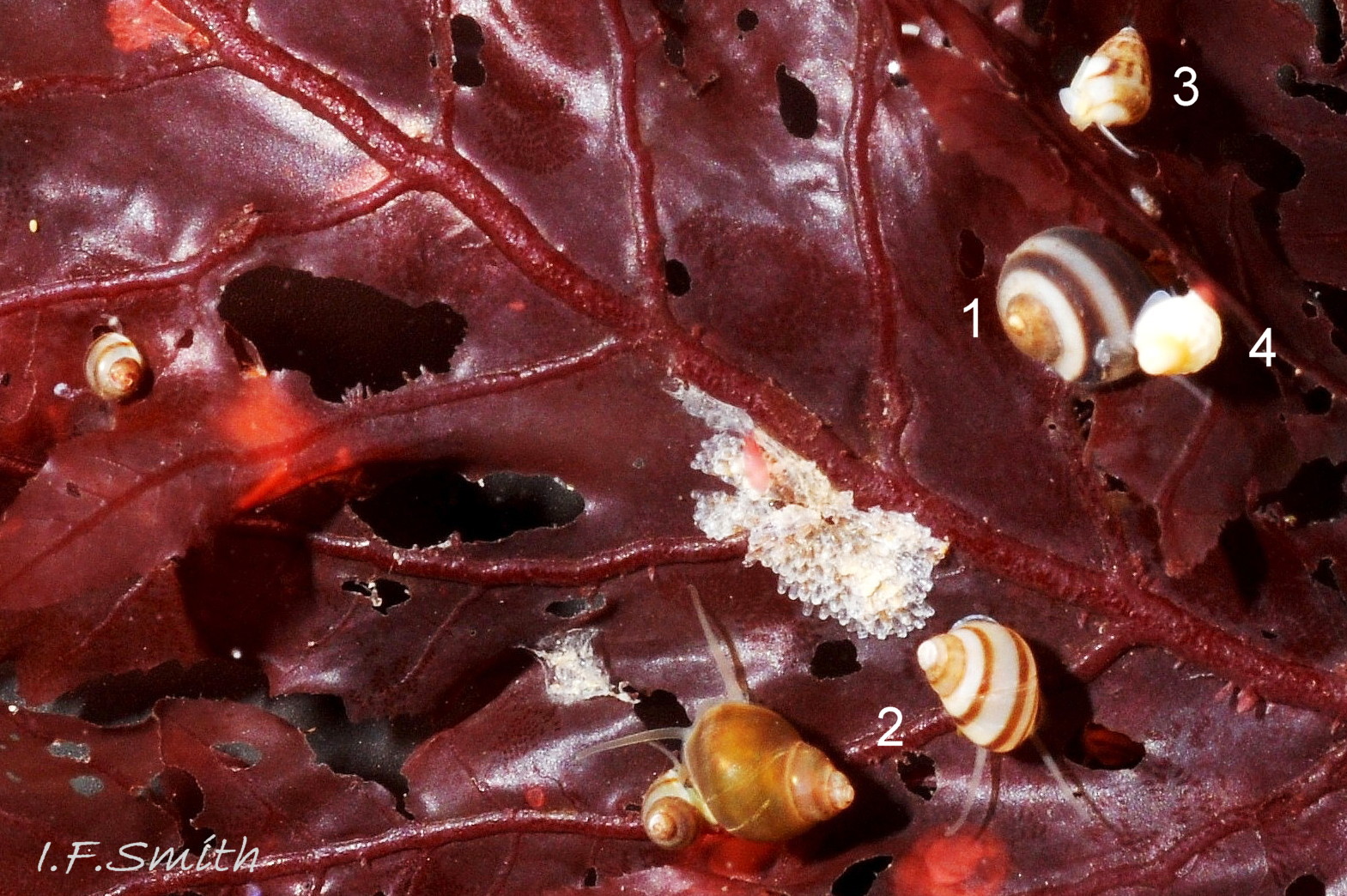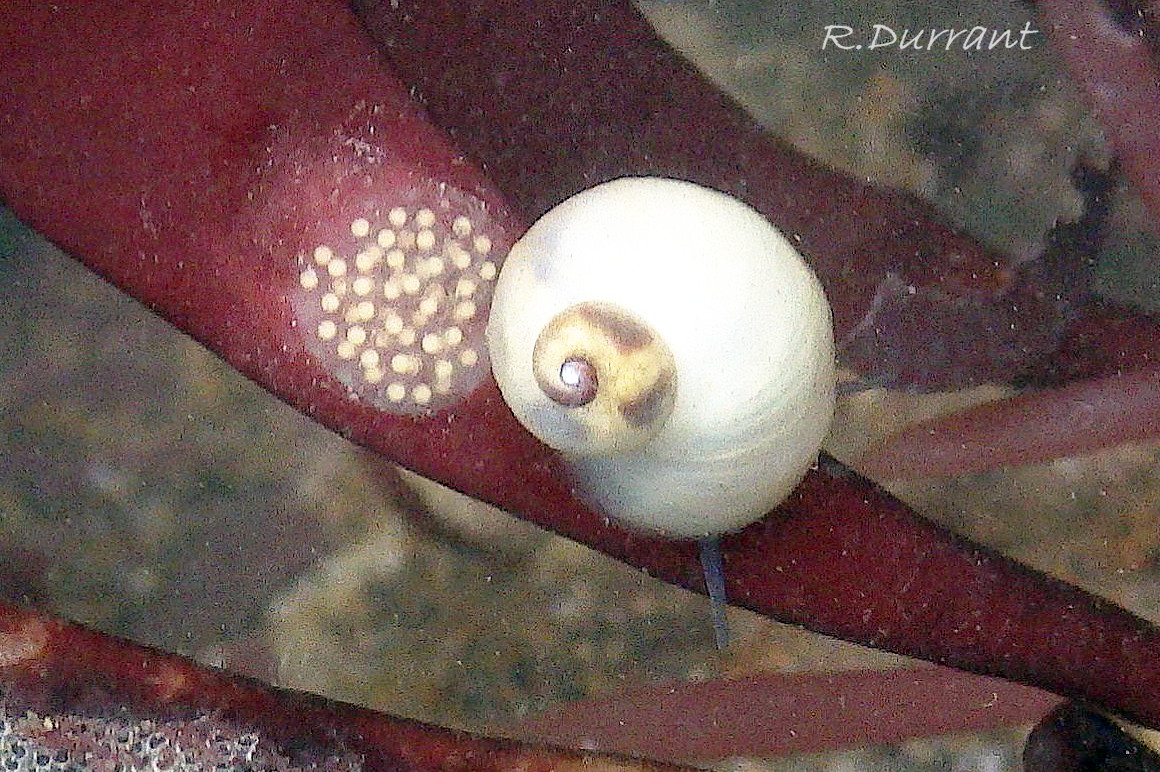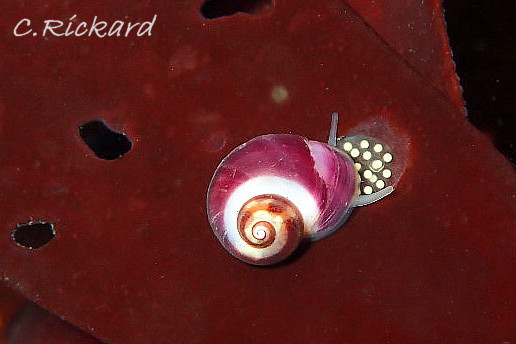Click image to enlarge with full caption. Main text below slider.
Lacuna parva (da Costa, 1778)
Revised PDF available at www.researchgate.net/publication/372761148_Lacuna_parva_d…
Synonyms: Cochlea parva da Costa, 1778; Lacuna puteolus (Turton, 1819).
Current taxonomy: WoRMS www.marinespecies.org/aphia.php?p=taxdetails&id=140169
Vernacular: Least chink shell; Gwichiad agennog bach (Welsh); Lille grubesnegl (Danish); Blek lagunsnäcka (Swedish); Kleine scheefhoren (Dutch); Kleine Grübchenschnecke (German).
Shell Description
The usual maximum shell height is 4 mm. It sometimes reaches 6 mm; shells from northern localities may be larger than southern specimens 01 Lacuna parva . It is a winter and spring-breeding annual. Growth is rapid so by August those in the Menai Strait, North Wales, from January spawning may reach 3.5 mm shell-height, nearly adult size, while those from later spawning may be less than 2 mm high 02 Lacuna parva. The blunt spire is 35% – 40% of the height of adults which are 4 mm or more high 01 Lacuna parva and 08 Lacuna parva. On early stage juveniles the spire protrudes little, or not at all, above the aperture 02 Lacuna parva . The body whorl is about 90% – 95% of the shell height 01 Lacuna parva & 06 Lacuna parva. The breadth of the shell is about equal to its height. The whorls are tumid with deep sutures. There is no obvious sculpture apart from very fine, numerous, prosocline growth lines 05 Lacuna parva . One exposed face of the hollow columella is missing, revealing a long columellar groove (“lacuna” or “chink”) 06 Lacuna parva with fine longitudinal ridges 04 Lacuna parva , leading to the umbilicus. The aperture is about 70% of the shell height on a 3 mm high shell 06 Lacuna parva and about 63% when (exceptionally) 6 mm high 01 Lacuna parva . On apertural-view images, the aperture occupies about 50% of the area. On females the aperture is higher than wide with the palatal (outer) lip everted to form a spout at the base 02 Lacuna parva ; on males there is little eversion and the aperture base is rounded with the width same as the height 01 Lacuna parva . The palatal (outer) lip turns and continues up the abapertural side of the columellar groove 01 Lacuna parva . The wide, white columellar lip forms the adapertural edge of columellar groove 06 Lacuna parva . The parietal lip is a whitish glaze on the surface of the body whorl 02 Lacuna parva . The adapical angle is about 90° 06 Lacuna parva . The operculum is a transparent ovoid, slightly yellowish, rapidly expanding spiral 04 Lacuna parva . The brownish or yellowish periostracum usually extends beyond the outer lip of the aperture 07 Lacuna parva . The glossy whitish shell 30 Lacuna parva occasionally has a lilac tint 08 Lacuna parva and most are tinted yellowish or brownish by the translucent periostracum 01 Lacuna parva . In Denmark and Scotland some of the shell may be pinkish brown (Fretter & Graham, 1980) or purplish 03 Lacuna parva . The protoconch lacks periostracum and is usually chalky white 05 Lacuna parva . Some shells lack bands 08 Lacuna parva , but the body whorl of many, the majority of adults in some populations, have three brown spiral bands 05 Lacuna parva . The basal two bands soon disappear into the aperture 06 Lacuna parva , and the lowest basal band is easily overlooked if the base of shell not examined. The adapical band may continue onto the next whorl, but it rapidly becomes indistinguishable. The bands sometimes seem to coalesce 03 Lacuna parva , but the form of three bands can usually be discerned in good lighting. The middle band is usually the broadest 06 Lacuna parva . The bands vary in intensity and shade of brown. The periostracum often dims the colour of the bands, which consequently are usually brighter within the aperture where there is no periostracum 07 Lacuna parva .
Body Description
The ground colour of the flesh on is translucent white or pale yellow 09 Lacuna parva , with a fine stipple of varying intensities of grey on adults, except on the sole, tentacles and tip of the snout 10 Lacuna parva . The snout is yellow internally and brightest at the tip. It is slit ventrally flic.kr/p/hrSMpp and its cross-section can change between circular with deep clefts 12 Lacuna parva , compressed into figure eight 10 Lacuna parva and shallow horseshoe 13 Lacuna parva . The translucent whitish cephalic tentacles are long and slender tapering to a blunt tip. They are almost smooth when extended 10 Lacuna parva and have a black eye on a basal bulge 12 Lacuna parva . Yellow internal viscera are visible behind the tentacles 14 Lacuna parva . Specimens with little or no grey stipple may have an overall yellowish body 09 Lacuna parva . The mantle colours are similar to those of the body; whitish 15 Lacuna parva , yellowish 09 Lacuna parva or stippled grey flic.kr/p/hrSThh . It is translucent showing the bands on the shell above 15 Lacuna parva . In the mantle cavity, the ctenidium is similar colour to it 16 Lacuna parva . The foot, when extended, is elongate with well rounded anterior and posterior edges 12 Lacuna parva . Its upper surface is usually translucent white, even on those with yellowish body, and usually stippled grey on adults and subadults. It has a large anterior pedal gland, which is sometimes distinguishable as a rounded area wider than the rest of the foot 17 Lacuna parva . It is widely bilaminate, with the lower layer lacking any grey stipple 09 Lacuna parva . The sole is translucent white and has a faint medial groove 17 Lacuna parva which is most obvious when the foot is folded along it 09 Lacuna parva . The opercular disc is yellowish 11 Lacuna parva or yellowish brown 15 Lacuna parva . There is a small, flat metapodial tentacle on each side of the rear of the opercular disc below the operculum, but often one is weakly developed and obscure as it fails to extend beyond the operculum 18 Lacuna parva .
Key identification features
Lacuna parva
1) Columellar groove (“lacuna” or “chink) leading to umbilicus 06 Lacuna parva .
2) Usual maximum height 4 mm; sometimes 6 mm. Spire 35% – 40% of adult shell height 01 Lacuna parva and 08 Lacuna parva. Spire smaller on shells less than 4 mm high 02 Lacuna parva .
3) On apertural-view images, aperture occupies about 50% or less of area 01 Lacuna parva . Apertures of juveniles 02 Lacuna parva may occupy more than 50% of the view and resemble the % on much larger shells of L. pallidula.
4) Body whorl has three brown spiral bands, basal band easily overlooked if base of shell not examined 05 Lacuna parva . Band 2 is often wider than bands 1 & 3. Some shells are uniform white 30 Lacuna parva or brown with no bands.
5) Body translucent white, with a fine stipple of varying intensities of grey on adults. No other colours except yellowish snout, and viscera showing through 14 Lacuna parva .
6) Found mainly, especially when young, on small red weeds, sometimes on fucoids.
Similar species
Lacuna pallidula (da Costa, 1778)
The spire and aperture proportions of early stage L. parva juveniles may resemble L. pallidula, but the much greater size of L. pallidula juveniles is obvious when the two are seen together. Adult L. parva resemble the size, but not the spire and aperture proportions of juvenile L. pallidula 19 Lacuna parva COMPARE Lacuna pallidula
1) Columellar groove, “chink”, leading to umbilicus 20 Lacuna parva COMPARE Lacuna pallidula
2) Maximum heights female 12 mm, male 6 mm. Hardly any of the spire protrudes beyond the body whorl.
3) On apertural-view images, ‘D’ shape aperture occupies about 70% of area 20 Lacuna parva COMPARE Lacuna pallidula .
4) Adult shell greenish-yellow; no spiral bands
fig. 20 20 Lacuna parva COMPARE Lacuna pallidula .
5) Body white, sometimes yellowish or pinkish; no grey stipple.
fig. 20 20 Lacuna parva COMPARE Lacuna pallidula .
6) Found mainly on Fucus serratus and sometimes on Laminaria.
Littorina fabalis (W. Turton, 1825) and L. obtusata (Linnaeus, 1758).
1) No columellar groove (chink, lacuna) or umbilicus 21 Lacuna parva COMPARE Littorina obtusata & L fabalis .
2) Up to 15 mm high and 17 mm wide. Very large body whorl and small spire.
3) On apertural-view images, aperture occupies about 50% of area 22 Lacuna parva COMPARE Littorina obtusata/fabalis .
4) Various colours and patterns including brown, white and yellow; some with bands 22 Lacuna parva COMPARE Littorina obtusata/fabalis .
5) Body varied shades of yellow, brown or black.
6) Found on Fucus serratus (L. fabalis) or Ascophyllum (L. obtusata) and on Fucus vesiculosus (both).
Lacuna vincta (Montagu, 1803)
1) Columellar groove (“lacuna” or “chink) leading to umbilicus 23 Lacuna parva COMPARE Lacuna vincta .
2) Maximum height about 10 mm. Well developed spire about 50% or more of adult shell height 24 Lacuna parva COMPARE Lacuna vincta , but juveniles less than 3 mm high have small spires of about 30% of shell height 25 Lacuna parva COMPARE Lacuna vincta .
3) On apertural-view images, aperture occupies about 50% of area on juveniles 23 Lacuna parva COMPARE Lacuna vincta and about 30% on full grown adults 24 Lacuna parva COMPARE Lacuna vincta .
4) Body whorl has four brown spiral bands, basal pair easily overlooked if base of shell not examined 24 Lacuna parva COMPARE Lacuna vincta .
5) Body whitish with grey; may also have yellow, orange, aquamarine or verdigris parts 26 Lacuna parva COMPARE Lacuna vincta .
6) Found on Laminaria and, especially juveniles, on small red weeds. Also on Zostera and sometimes on fucoids.
Lacuna crassior (Montagu, 1803)
1) Wide white columellar shelf; groove/chink and umbilicus absent or very small 27 Lacuna parva COMPARE Lacuna crassior .
2) Distinct spire about 50% of mature shell height, about 45% when younger 27 Lacuna parva COMPARE Lacuna crassior .
3) On apertural-view images, aperture occupies about 30 % of area.
4) Fresh shell in water has periostracum raised in distinct transverse (costal) ridges. Dried vacant shell, dull yellowish-brown if periostracum retained 27 Lacuna parva COMPARE Lacuna crassior, yellowish-white or pinkish-white with faint spiral lines if periostracum worn off .
5) Body translucent whitish 28 Lacuna parva COMPARE Lacuna crassior .
6) A rare species which associates with the bryozoan Alcyonidium diaphanum.
Habits and ecology
L. parva feeds on Fucus serratus, F. vesiculosus, and small red algae, including Nitophyllum laciniatum, Chondrus crispus, Ceramium, Phycodrys rubens29 Lacuna parva , Cryptopleura ramosa , Phyllophora and Gigartina mamillata near low water on rocky shores. It is absent from shores where turbidity prevents algal growth at low water. It moves with a bipedal stepping motion, lifting alternately right and left of its foot on either side of a central groove 17 Lacuna parva . It breeds in late winter or early spring in Britain. In a sparse population in the Øresund, about 10 ova were deposited in 2 mm diameter hemispheres of clear jelly on algae, especially Phyllophora (Ockelmann & Nielsen, 1981). Elsewhere, each mass may have about 50 or 20 ova 30 Lacuna parva and 31 Lacuna parva . There is no free-living veliger stage as ova hatch into crawling juvenile snails. All adults die after breeding, so only juveniles are found in early summer, but growth is rapid so some reach 3.5 mm height by August 02 Lacuna parva .
Distribution and status
L. parva occurs from the Arctic to Bretagne (France) and New England (USA). It is absent from the Baltic. GBIF map www.gbif.org/species/2301173 It lives all around Britain and Ireland where conditions permit growth of food-algae; it is not recorded from the north-east Irish Sea and is absent or very scarce alive in the southern North Sea. UK map NBN species.nbnatlas.org/species/NBNSYS0000175976
Acknowledgements
For use of images, I thank Rob Durrant and Chris Rickard.
Links and references
Forbes, E. & Hanley S. 1849-53. A history of the British mollusca and their shells. vol. 3 (1853), London, van Voorst. ( As Lacuna puteolusarchive.org/details/historyofbritish03forbe/page/58/mode/2up
And plate LXX11 at end of vol.4, fig. 1 & 2, also fig. 3 & 4 labelled “patula” = juvenile L. pallidula archive.org/details/historyofbritish04forbe/page/n459
Fretter, V. and Graham, A. 1962. British prosobranch molluscs: their functional anatomy and ecology. London, Ray Society.
Fretter, V. and Graham, A. 1980. The prosobranch molluscs of Britain and Denmark. Part 5 – Marine Littorinacea. J. Moll. Stud. Suppl. 7.
Graham, A. 1988. Molluscs: prosobranch and pyramidellid gastropods. Synopses of the British Fauna (New Series) no.2 (Second edition). Leiden, E.J.Brill/Dr. W. Backhuys. 662 pages.
Jeffreys, J.G. 1862-69. British conchology. vol. 3 (1865). London, van Voorst. (As Lacuna puteolus); archive.org/details/britishconcholog03jeffr . pp.348- 351.
Ockelmann, K. W. and Nielsen, C. 1981. On the biology of the prosobranch Lacuna parva in the Øresund. Ophelia 20: 1-16.
Abstract at www.tandfonline.com/doi/abs/10.1080/00785236.1981.10426559
Glossary
aperture = mouth of gastropod shell; outlet for head and foot.
apical = at or near the apex.
abapertural = away from the aperture.
adapertural = towards the aperture.
adapical = towards the apex of the shell.
chink = (see columellar groove).
columella = solid or hollow axial “little column” around which gastropod shell spirals; hidden inside shell, except on final whorl next to lower part of inner (parietal) lip of aperture where hollow ones may end in an umbilicus and columellar groove .
columellar = (adj.) of or near central axis of spiral gastropod,
columellar groove = groove where one face of hollow columella missing, originates in umbilicus. Also called “lacuna” or “chink”.
columellar lip = lower (abapical) part of inner lip of aperture.
cephalic = (adj.) of the head.
costa = (pl. costae) strong rib running across a whorl of a gastropod shell.
ctenidium = comb-like molluscan gill; usually an axis with a row of filaments either side.
height = (of gastropod shells) distance from apex of spire to base of aperture.
lacuna = (see columellar groove) a small cavity, pit, or discontinuity in an anatomical structure.
LW = low water mark.
mantle = sheet of tissue that secretes the shell and forms a cavity for the gill in most marine molluscs.
metapodial = (adj.) on or of the metapodium (hind part of foot).
metapodium = hind part of the foot.
operculum = horny plate used to close shell aperture.
palatal lip = outer lip of gastropod aperture.
parietal lip = upper (adapical) part of inner lip of gastropod aperture that lies, often as a glaze, on surface of whorl.
periostracum = thin horny layer of chitinous material often coating shells.
prosocline = (adj. of line or sculpture) obliquely across snail whorl with end nearest apex tilted towards aperture.
protoconch = apical whorls produced during embryonic and larval stages of gastropod.
suture = groove or line where whorls adjoin.
umbilicus = hole or chink on base of shell, often sealed over.
veliger = shelled larva of marine gastropod or bivalve mollusc which swims by beating cilia of a velum.
velum = bilobed flap on veliger larva, with beating cilia for swimming.
